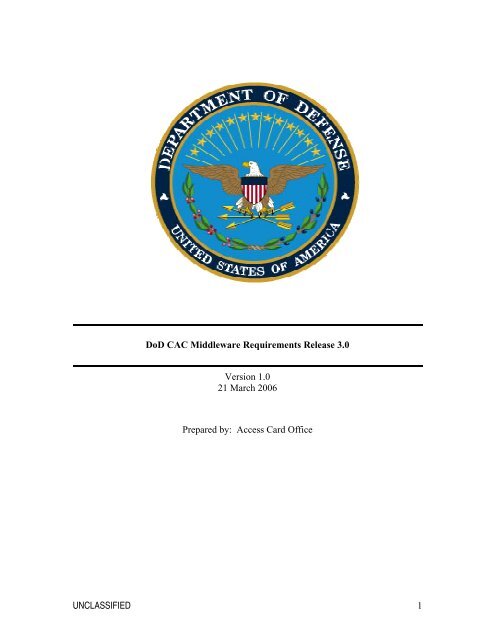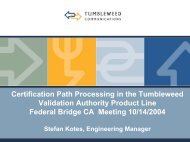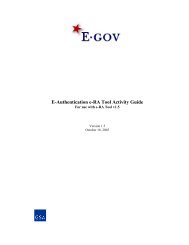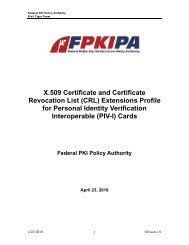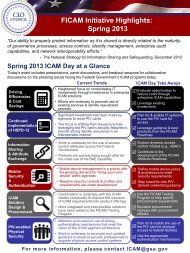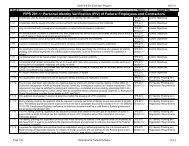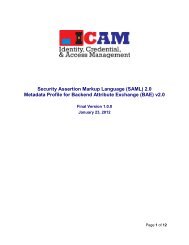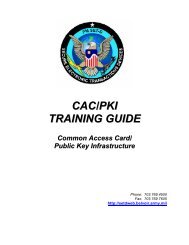DoD CAC Middleware Requirements - IDManagement.gov
DoD CAC Middleware Requirements - IDManagement.gov
DoD CAC Middleware Requirements - IDManagement.gov
Create successful ePaper yourself
Turn your PDF publications into a flip-book with our unique Google optimized e-Paper software.
<strong>DoD</strong> <strong>CAC</strong> <strong>Middleware</strong> <strong>Requirements</strong> Release 3.0<br />
Version 1.0<br />
21 March 2006<br />
Prepared by: Access Card Office<br />
UNCLASSIFIED 1
TABLE OF CONTENTS<br />
1 Introduction ...............................................................................................................6<br />
1.1 Background .......................................................................................................6<br />
1.2 Purpose .............................................................................................................6<br />
1.3 Audience ...........................................................................................................6<br />
1.4 Document Scope...............................................................................................6<br />
1.5 Document Objectives ........................................................................................6<br />
1.6 Assumptions and Constraints............................................................................7<br />
1.7 Abbreviations.....................................................................................................7<br />
2 <strong>Middleware</strong> Background............................................................................................9<br />
2.1 <strong>Middleware</strong> Definitions ......................................................................................9<br />
2.2 Cryptographic Services .....................................................................................9<br />
2.3 <strong>CAC</strong> Data ..........................................................................................................9<br />
2.4 <strong>CAC</strong> Management.............................................................................................9<br />
2.5 New Card Type .................................................................................................9<br />
2.6 New Applet ........................................................................................................9<br />
2.7 Modified Applet..................................................................................................9<br />
3 <strong>Middleware</strong> <strong>Requirements</strong> ......................................................................................10<br />
3.1 <strong>Requirements</strong> Structure ..................................................................................10<br />
3.1.1 Core <strong>DoD</strong>.................................................................................................10<br />
3.1.2 Optional ...................................................................................................10<br />
3.1.3 CC/S/A.....................................................................................................10<br />
4 Core <strong>DoD</strong> <strong>Requirements</strong>.........................................................................................11<br />
4.1 Support for FIPS 201 and Associated Special Publications............................11<br />
4.2 Card Interfaces................................................................................................11<br />
UNCLASSIFIED 2
4.2.1 <strong>Middleware</strong> shall support all card-edge command sets for: ....................11<br />
4.2.2 BSI <strong>Requirements</strong> ...................................................................................11<br />
4.3 PKI <strong>Requirements</strong> ...........................................................................................11<br />
4.3.1 Cryptographic Service Provider (CSP) ....................................................11<br />
4.3.2 PKCS 11..................................................................................................12<br />
4.4 Common Access Card (<strong>CAC</strong>) .........................................................................12<br />
4.4.1 Minimum Supported <strong>CAC</strong>s: .....................................................................12<br />
4.4.2 New Card Types......................................................................................12<br />
4.4.3 Card Applets............................................................................................13<br />
4.4.4 Certificates...............................................................................................13<br />
4.5 <strong>Middleware</strong> Operating Environment ................................................................13<br />
4.6 Card Readers ..................................................................................................13<br />
4.7 Application Support .........................................................................................14<br />
4.7.1 E-mail ......................................................................................................14<br />
4.7.2 Cryptographic Logon ...............................................................................14<br />
4.7.3 Client Authentication................................................................................15<br />
4.7.4 Additional Applications ............................................................................15<br />
4.8 Graphical User Interface .................................................................................15<br />
4.8.1 <strong>Requirements</strong> for a Graphical User Interface (GUI) ................................15<br />
4.9 <strong>Middleware</strong> Resource Parameters ..................................................................15<br />
4.9.1 Disk Space and Workstation <strong>Requirements</strong> ............................................15<br />
4.10 <strong>Middleware</strong> Installation....................................................................................16<br />
4.10.1 <strong>Middleware</strong> Behavior ...............................................................................16<br />
4.11 <strong>Middleware</strong> Configuration................................................................................16<br />
4.11.1 Configurations .........................................................................................16<br />
4.12 PIN Management ............................................................................................17<br />
UNCLASSIFIED 3
4.12.1 PIN Services............................................................................................17<br />
4.12.2 PIN Change .............................................................................................17<br />
4.12.3 PIN Validation..........................................................................................17<br />
4.13 Documentation ................................................................................................18<br />
4.13.1 End-User Documentation ........................................................................18<br />
4.13.2 Administrator Documentation ..................................................................18<br />
4.13.3 BSI Documentation for Application Developers.......................................19<br />
4.14 Process Descriptions.......................................................................................19<br />
4.14.1 <strong>Middleware</strong> Functions..............................................................................19<br />
4.14.2 Use of Scratch Pad Space ......................................................................19<br />
4.14.3 Support ....................................................................................................20<br />
4.14.4 Event Logging..........................................................................................20<br />
5 Optional...................................................................................................................21<br />
5.1 General............................................................................................................21<br />
5.2 <strong>Middleware</strong> Operating Environment ................................................................21<br />
5.3 PIN Services....................................................................................................22<br />
5.4 Documentation ................................................................................................22<br />
5.5 Support............................................................................................................22<br />
5.5.1 Technical Support....................................................................................22<br />
5.5.2 Vendor Support .......................................................................................22<br />
5.5.3 Future Enhancements .............................................................................22<br />
6 <strong>Middleware</strong> Qualifications .......................................................................................24<br />
Appendix A......................................................................................................................25<br />
Appendix B- CSP Functions............................................................................................29<br />
Appendix C- PKCS 11 Functions....................................................................................30<br />
Appendix D- BSI Functions.............................................................................................32<br />
UNCLASSIFIED 4
Appendix E- BSI Header Files ........................................................................................33<br />
Appendix F- References ................................................................................................34<br />
Government References .............................................................................................34<br />
Industry References ....................................................................................................34<br />
UNCLASSIFIED 5
1 Introduction<br />
1.1 Background<br />
In May of 1999, the Deputy Secretary of Defense (DEPSECDEF) issued a policy memorandum<br />
mandating the implementation of a single, integrated Public Key Infrastructure (PKI) across the<br />
Department of Defense (<strong>DoD</strong>). This policy mandated that the <strong>DoD</strong> PKI be used to digitally sign<br />
all email, support mutual authentication to private web sites, cryptographically authenticate to<br />
computer networks, and be used in <strong>DoD</strong> applications when appropriate. In November of 1999, a<br />
Smart Card policy memo was issued by the DEPSECDEF which required that a Common Access<br />
Card (<strong>CAC</strong>), based on smart card technology, be used as the primary identification card for <strong>DoD</strong><br />
personnel, support building access, and be the token for PKI credentials. More recently,<br />
Homeland Security Presidential Directive-12 [HSPD-12] mandates the implementation of a<br />
Federal Information Processing Standard 201 [FIPS 201] Personal Identity Verification (PIV) of<br />
Federal Employees and Contractors. The <strong>DoD</strong> <strong>CAC</strong> and <strong>DoD</strong> PKI programs are being aligned<br />
to meet this additional set of requirements.<br />
The <strong>DoD</strong> established a <strong>Middleware</strong> Sub-Work Group (MSW) under the <strong>CAC</strong> Configuration<br />
Management Working Group (CMWG) of the Identity Protection and Management Senior<br />
Coordinating Group (IPMSCG) to consolidate and document the baseline middleware<br />
requirements across the <strong>DoD</strong>. This middleware requirements document represents the consensus<br />
of the participating members of the MSW.<br />
1.2 Purpose<br />
The <strong>Middleware</strong> <strong>Requirements</strong> defines the standard set of services, interfaces, and configuration<br />
options that must be implemented by all middleware for use on supported Microsoft-Intel<br />
(WINTEL) server and desktop operating systems platforms within the <strong>DoD</strong>. Additionally, this<br />
document identifies recommended and optional capabilities that middleware providers should<br />
consider implementing to differentiate their products and provide added value. The core<br />
requirements remain applicable in other operating environments, but Combatant Commands,<br />
Services and Agencies (CC/S/A) are free to tailor the requirements for these environments.<br />
1.3 Audience<br />
This document is intended for middleware providers, acquirers, testers, and application<br />
developers.<br />
1.4 Document Scope<br />
This document applies to middleware that operates on personal computer desktops, servers,<br />
laptops and other fully functioning WINTEL environments.<br />
1.5 Document Objectives<br />
The objective of this document is to provide unambiguous and testable requirements for<br />
middleware vendors to support requisite acquisition efforts by <strong>DoD</strong> organizations.<br />
UNCLASSIFIED 6
1.6 Assumptions and Constraints<br />
Each CC/S/A in the <strong>DoD</strong> will execute middleware acquisitions using processes and procedures<br />
available to that organization. It is expected that this document will serve as the centerpiece of<br />
the acquisition and it is expected additional requirements (such as level of technical support<br />
service or unique product capabilities) will be specified by each CC/S/A in Section 6.<br />
1.7 Abbreviations<br />
ATR Answer to Reset<br />
BSI Basic Services Interface<br />
<strong>CAC</strong> Common Access Card<br />
CAM Card Authentication Management<br />
CC/S/A Combatant Command, Service, Agency<br />
CMWG Configuration Management Working Group<br />
COTS Commercial Off The Shelf<br />
CPU Central Processing Unit<br />
CSP Cryptographic Service Provider<br />
<strong>DoD</strong> Department of Defense<br />
EDIPI Electronic Data Interchange Personal Identifier<br />
FIPS Federal Information Processing Standard<br />
GSC Government Smart Card<br />
GSC-IS Government Smart Card – Interoperability Standard<br />
IPMSCG Identity Protection and Management Senior Coordinating<br />
Group<br />
MS-CAPI Microsoft Cryptographic API<br />
MSI Microsoft Windows Installer Package<br />
MSW <strong>Middleware</strong> Sub-working Group<br />
PKCS11 Public Key Cryptography Standard #11<br />
UNCLASSIFIED 7
PKI Public Key Infrastructure<br />
PIN Personal Identification Number<br />
PIV Personal Identity Verification<br />
UNCLASSIFIED 8
2 <strong>Middleware</strong> Background<br />
2.1 <strong>Middleware</strong> Definitions<br />
<strong>Middleware</strong> is defined as the software application that serves as the interface between host<br />
applications (such as email, cryptographic network logon, web browsers, and PK-enabled<br />
applications) and the <strong>CAC</strong>. Functionally, middleware provides access to cryptographic services,<br />
<strong>CAC</strong> data, and <strong>CAC</strong> management features.<br />
2.2 Cryptographic Services<br />
Cryptographic services are the set of functions necessary for cryptographic operations, such as<br />
signing and encrypting email. <strong>Middleware</strong> provides cryptographic services through three<br />
standards-based interfaces: MS-CAPI, PKCS11, and BSI.<br />
2.3 <strong>CAC</strong> Data<br />
<strong>CAC</strong> data is defined as non-cryptographic data stored on the <strong>CAC</strong> such as Person Identifier and<br />
blood type.<br />
2.4 <strong>CAC</strong> Management<br />
<strong>CAC</strong> management is the set of functions necessary to manage the card and the middleware<br />
environment, such as PIN changes and PIN timeout.<br />
2.5 New Card Type<br />
A new card type is a smart card that is functionally equivalent to the <strong>CAC</strong> that is currently being<br />
issued, which has been selected by the <strong>DoD</strong> to replace the <strong>CAC</strong> in the future. Functional<br />
equivalency means that new features and changes in the middleware are restricted to version<br />
updates within a software release and changes required to make the <strong>CAC</strong> operational.<br />
2.6 New Applet<br />
A new applet is an applet, approved for use on the <strong>CAC</strong> by <strong>DoD</strong>, that provides unique<br />
functionality not available with current approved <strong>DoD</strong> applets. A new instantiation of an<br />
existing applet, for example a Generic Container Applet, is not a new applet.<br />
2.7 Modified Applet<br />
A modified applet is an applet, previously approved for use on the <strong>CAC</strong> by <strong>DoD</strong>, where the<br />
functionality, data and/or layout is changed to accommodate new features, requirements, or<br />
capabilities. A new instantiation of a modified PKI Container Applet would be an example of a<br />
modified applet.<br />
UNCLASSIFIED 9
3 <strong>Middleware</strong> <strong>Requirements</strong><br />
3.1 <strong>Requirements</strong> Structure<br />
3.1.1 Core <strong>DoD</strong><br />
<strong>Requirements</strong> listed in the Core <strong>DoD</strong> <strong>Requirements</strong> section of the document are mandatory, and<br />
middleware vendors must have 100% compliance in order to be considered for <strong>DoD</strong> purchase.<br />
Core requirements pertain to interoperability, core middleware functionality, and middleware<br />
architecture.<br />
Core <strong>DoD</strong> requirements are listed in section 4.<br />
3.1.2 Optional<br />
Optional requirements are those which the <strong>DoD</strong> considers desirable but not mandatory. The<br />
majority of these requirements will be based on each individual purchaser’s preference and/or<br />
unique circumstances. A good example of an optional requirement is support for other non-<strong>DoD</strong><br />
card types.<br />
Optional requirements are listed in this document because a) they are value added and<br />
differentiators among middleware vendors, and b) it is likely that some variation of these<br />
requirements will appear in individual CC/S/A acquisition documentation. Similarly, it is<br />
possible requirements listed in the “optional” section will appear as “required” in individual<br />
CC/S/A acquisitions.<br />
Optional requirements are listed in section 5.<br />
3.1.3 CC/S/A<br />
Service-specific requirements will be identified in section 7.<br />
UNCLASSIFIED 10
4 Core <strong>DoD</strong> <strong>Requirements</strong><br />
4.1 Support for FIPS 201 and Associated Special Publications<br />
4.1.1 <strong>Middleware</strong> shall support NIST Special Publication 800-85<br />
4.1.2 <strong>Middleware</strong> shall be certified by an approved NIST laboratory to be FIPS 201 compliant<br />
4.1.3 <strong>Middleware</strong> vendors shall migrate product offerings, as part of routine maintenance, to<br />
support any updates or adjustments to FIPS 201 and any applicable NIST Special<br />
Publication.<br />
4.2 Card Interfaces<br />
4.2.1 <strong>Middleware</strong> shall support all card-edge command sets for:<br />
4.2.1.1 National Institute of Standards and Technology’s Special Publication 800-73,<br />
“Interfaces for Personal Identity Verification,” April 2005<br />
4.2.1.2 <strong>CAC</strong> Developer’s Kit version 3.3 February 2006 located at<br />
www.dmdc.osd.mil/smartcard. Those outside of .<strong>gov</strong> or .mil domains that desire access<br />
to the CDK should inquire at cacsupport@osd.pentagon.mil.<br />
4.2.1.3 <strong>DoD</strong> Implementation Guide for PIV II SP 800-73 Interface DRAFT Version 0.47<br />
located at www.dmdc.osd.mil/smartcard. Those outside of .<strong>gov</strong> or .mil domains that<br />
desire access to the implementation guide should inquire at<br />
cacsupport@osd.pentagon.mil.<br />
4.2.1.4 National Institute of Standards and Technology – Technology Administration U.S.<br />
Department of Commerce, Government Smart Card Interoperability Specification.<br />
Version 2.1, July 12, 2003, http://smartcard.nist.<strong>gov</strong><br />
4.2.2 BSI <strong>Requirements</strong><br />
4.2.2.1 BSI shall be implemented and compliant in accordance with NIST Government Smart<br />
Card Interoperability Specification v2.1, 16 July 2003.<br />
4.2.2.2 <strong>Middleware</strong> shall provide a BSI implementation per specifications and requirements<br />
listed in Appendix D.<br />
4.3 PKI <strong>Requirements</strong><br />
4.3.1 Cryptographic Service Provider (CSP)<br />
4.3.1.1 <strong>Middleware</strong> shall provide a compliant CSP interface as specified in the Microsoft<br />
Cryptography API Service Provider documentation.<br />
UNCLASSIFIED 11
4.3.1.2 <strong>Middleware</strong> shall provide a smart card compliant CSP, as documented in Smart Card<br />
CSP Notes, available from the<br />
http://www.microsoft.com/downloads/details.aspx?familyid=0F436C75-2304-42BB-<br />
B81A-BA0C2C47BAC2&displaylang=en Web site.<br />
4.3.1.3 Microsoft shall sign the middleware CSP for Microsoft operating environments<br />
4.3.1.4 CSP shall be compliant with the CSP requirements listed in Appendix B, CSP<br />
Functions.<br />
4.3.2 PKCS 11<br />
4.3.2.1 <strong>Middleware</strong> shall support PKCS11 functions listed in Appendix C, PKCS11 Functions<br />
4.3.2.2 Vendor shall provide a list of all unsupported PKCS11 functions<br />
4.4 Common Access Card (<strong>CAC</strong>)<br />
4.4.1 Minimum Supported <strong>CAC</strong>s:<br />
4.4.1.1 Oberthur GalactIC 2.1-5032 Mask 2.1R<br />
4.4.1.2 Schlumberger Cyberflex Access 32K <strong>CAC</strong> SM7v2<br />
4.4.1.3 Oberthur CosmopolIC V4<br />
4.4.1.4 Axalto Cyberflex Access 64K V1 SM4v1<br />
4.4.1.5 Gemplus GemXpresso ProR3 E64K PK- FIPS V1<br />
4.4.1.6 Gemplus GemXpresso Pro R3 E64K PK- FIPS V2 Normal ATR<br />
4.4.1.7 Axalto Cyberflex Access 64K V1 SM4v2<br />
4.4.1.8 Oberthur ID-One Cosmo 64K 5.2 DI<br />
4.4.2 New Card Types<br />
4.4.2.1 <strong>Middleware</strong> vendor shall provide support for the ability to utilize future card types (e.g.<br />
recognition of new Answer to Reset (ATR) codes) as issued by the <strong>CAC</strong> Program or<br />
other Federal PIV programs.<br />
4.4.2.2 <strong>Middleware</strong> vendor shall provide documentation describing the middleware’s software<br />
architecture for supporting new card types. Areas of interest to the <strong>DoD</strong> are modularity<br />
and methodology.<br />
4.4.2.3 <strong>Middleware</strong> vendor shall provide documentation describing the process by which new<br />
card types shall be added to the middleware desktop configuration.<br />
UNCLASSIFIED 12
4.4.2.4 <strong>Middleware</strong> shall be able to utilize “new card types” without the need to restart the<br />
middleware services running on the computer.<br />
4.4.3 Card Applets<br />
4.4.3.1 <strong>Middleware</strong> shall support all current and modified <strong>DoD</strong> <strong>CAC</strong> applets. (e.g., ID applet,<br />
Generic container applets, PKI applet, PIN management applet, Access Control Applet).<br />
4.4.3.2 Support for new <strong>CAC</strong> applets may be considered routine maintenance.<br />
4.4.3.3 Support for applet changes may be provided no later than 30 days after the vendor<br />
receives a request from the <strong>DoD</strong>.<br />
4.4.4 Certificates<br />
4.4.4.1 <strong>Middleware</strong> shall support all <strong>DoD</strong> <strong>CAC</strong>s and <strong>DoD</strong> and Federally issued PIV cards using<br />
X.509 formatted PKI digital certificates.<br />
4.4.4.2 <strong>Middleware</strong> shall support all certificate types issued under the <strong>DoD</strong> and Federal PKI<br />
certificate policies.<br />
4.4.4.3 <strong>Middleware</strong> shall process and use certificates for PK services in accordance with key<br />
usage and key extension policies.<br />
4.4.4.4 <strong>Middleware</strong> shall not depend on the presence of a specific certificate to support<br />
cryptographic functions of another certificate. For example, the identity certificate need<br />
not be present in order to use the email signing and encryption certificates.<br />
4.5 <strong>Middleware</strong> Operating Environment<br />
Operating System <strong>Requirements</strong><br />
<strong>Middleware</strong> shall operate with the following operating systems:<br />
Operating Systems Supported by <strong>Middleware</strong><br />
Windows 2000 Server<br />
Windows 2003 Server<br />
4.6 Card Readers<br />
Windows 2000 Service Pack 4<br />
Thin Client (Citrix)<br />
Fat Client (Citrix)<br />
Windows XP Professional<br />
Service Pack SP2<br />
Windows XP Home SP2<br />
Windows Vista (not later<br />
than six months after public<br />
release)<br />
<strong>Middleware</strong> shall operate and comply with any reader that is ISO 7816 (5v, 60mA) compatible,<br />
Personal Computer/Smart Card (PC/SC) Windows Hardware Quality Labs (WHQL) Logo<br />
UNCLASSIFIED 13
certified. Additionally, middleware destined for workstations other than WINTEL shall be<br />
interoperable with PC/SC Movement for the Use of Smart Cards in a Linux Environment<br />
(M.U.S.C.L.E) certified and Open Card Framework (OCF) compliant reader drivers.<br />
<strong>Middleware</strong> shall operate with reader drivers that are compatible with Windows 2000 client,<br />
Windows XP client, and Windows 2000 Server and Windows 2003 Server operating systems<br />
4.7 Application Support<br />
4.7.1 E-mail<br />
The middleware shall provide cryptographic services to the email application and operating<br />
system combinations as listed in Appendix A, Figure 5, Primary Email and OS Combinations to:<br />
Sign, decrypt, and encrypt email messages with or without attachments. The middleware MUST<br />
NOT be dependent on the email address within any x.509 certificate in order to configure or<br />
utilize a certificate as part of a middleware feature/function.<br />
4.7.2 Cryptographic Logon<br />
4.7.2.1 The middleware shall provide the means to conduct cryptographic authentication to<br />
<strong>DoD</strong> applications and operating systems.<br />
4.7.2.1.1 The middleware shall support Microsoft Smart Card Logon functionality<br />
inherent to the Microsoft Windows 2000 and XP Client operating systems in a<br />
Microsoft Windows 2000 and/or 2003 Active Directory Domain. The<br />
middleware shall have the ability to use any appropriate <strong>DoD</strong> certificate as<br />
indicated by the User Principal Name in the certificate's Subject Alternative<br />
name field and the following "Enhanced Key Usage" extensions:<br />
Smart Card Logon (1.3.6.1.4.1.311.20.2.2)<br />
Secure Email(1.3.6.1.5.5.7.3.4)<br />
Client Authentication(1.3.6.1.5.5.7.3.2)<br />
4.7.2.1.2 The middleware shall support the Microsoft Smart Card Logon functionality<br />
inherent to Microsoft Windows Vista six months after its release.<br />
4.7.2.1.3 The middleware shall have the capability to display all appropriate certificates<br />
on the <strong>CAC</strong> to allow the user to select the correct certificate and key pair<br />
provided that Microsoft Smart Card Logon functionality permits this<br />
capability.<br />
4.7.2.1.4 If a single certificate on the <strong>CAC</strong> is configured for Microsoft Smart Card<br />
Logon, the middleware shall be capable of making use of it without prior user<br />
or system action.<br />
4.7.2.1.5 The middleware shall support cryptographic authentication to <strong>DoD</strong><br />
applications utilizing the Federal Personal Identity Verification (PIV)<br />
UNCLASSIFIED 14
standards as a common authentication framework by implementing the PIV<br />
<strong>Middleware</strong> and PIV Card Application Conformance Test Guidelines and the<br />
middleware shall obtain a National Institute of Standard and Technology<br />
Personal Identity Verification Program (NPIVP) validation certificate.<br />
4.7.3 Client Authentication<br />
4.7.3.1 The middleware shall support authentication, digital signature, and encryption<br />
functions, to include SSL V3 and TLS with browsers and operating systems as specified<br />
in Appendix A, Figure 5, Web Servers.<br />
4.7.3.2 The middleware shall support client authentication, which requires a ‘PIN Always’<br />
access control rule. <strong>Middleware</strong> must be configurable at an application and/or<br />
capability level.<br />
4.7.3.3 The middleware shall support the migration to larger keys and different algorithms as<br />
outlined in NIST special publications 800-73 and 800-78.<br />
4.7.4 Additional Applications<br />
4.7.4.1 The middleware shall support Citrix Metaframe FR3 and Presentation Server 4.0<br />
4.8 Graphical User Interface<br />
4.8.1 <strong>Requirements</strong> for a Graphical User Interface (GUI)<br />
4.8.1.1 There shall be a single middleware graphical interface or utility to manipulate the<br />
middleware’s features and configuration.<br />
4.8.1.2 <strong>Middleware</strong> shall, by default place an icon in the system tray for indicating middleware<br />
activity (e.g. card access indicator) and launching the middleware graphical interface.<br />
4.8.1.3 All configurable features should be presented in the GUI. Only items relative to the<br />
context of the user or administrator should be displayed (e.g. Administrative features<br />
that would otherwise not be configurable by the user should not be displayed to the<br />
user, etc.).<br />
4.8.1.4 <strong>Middleware</strong> shall have the ability to display all fields from the x.509 certificate for each<br />
certificate type stored on <strong>CAC</strong>.<br />
4.9 <strong>Middleware</strong> Resource Parameters<br />
4.9.1 Disk Space and Workstation <strong>Requirements</strong><br />
4.9.1.1 The maximum disk space required for <strong>CAC</strong> middleware installation on a client<br />
workstation shall not exceed 30 Mbytes and, for a server, shall not exceed 100 Mbytes.<br />
4.9.1.2 The <strong>CAC</strong> middleware shall function properly on a client workstation with a minimum<br />
233 MHz Intel Pentium/Celeron family, or AMD K6/Athlon/Duron family with a<br />
UNCLASSIFIED 15
minimum of 128 megabytes of RAM. The middleware shall consume no appreciable<br />
(i.e. less then 1%) CPU time when in an idle state and shall not exceed 10% (ten<br />
percent) of the system’s total resources at rest.<br />
4.10 <strong>Middleware</strong> Installation<br />
4.10.1 <strong>Middleware</strong> Behavior<br />
4.10.1.1 <strong>Middleware</strong> shall support software push capability for installation such as Microsoft<br />
SMS, and when installation will be on a Microsoft Operating system, shall utilize a<br />
".msi" installation package.<br />
4.10.1.2 <strong>Middleware</strong> shall not install card reader drivers.<br />
4.10.1.3 <strong>Middleware</strong> shall alert the user if no card reader is connected to the workstation.<br />
4.10.1.4 <strong>Middleware</strong> shall have the ability to uninstall completely in each supported operating<br />
system. Uninstall should include the removal of any registry entries added during<br />
installation as well as changing any registry settings that were modified at the time of<br />
install back to those settings prior to installation. This includes, but is not limited to, the<br />
required registry entries used for discovery purposes as specified in this document as<br />
well as any vendor-specific registry entries that may be added during installation.<br />
Vendors are recommended to use standardized installation tools such as Microsoft<br />
Installer.<br />
4.10.1.5 <strong>Middleware</strong> shall not remove any registry settings or files that are shared by other<br />
applications or not wholly linked to vendor-specific functionality. For example, if a<br />
middleware package upgrades the browser’s crypto strength to 128 bit, the middleware<br />
would not remove the upgrade because it is shared by other non-middleware<br />
applications.<br />
4.11 <strong>Middleware</strong> Configuration<br />
4.11.1 Configurations<br />
4.11.1.1 <strong>Middleware</strong> shall support central and remote administration of all configuration<br />
settings. For Microsoft OS's, all configuration options must be stored in the registry<br />
and maintainable via group policy for central administration.<br />
4.11.1.2 <strong>Middleware</strong> shall have the ability to enable or disable any and all configurable settings<br />
for the end user at time of installation.<br />
4.11.1.3 <strong>Middleware</strong> configuration settings shall be set and configured in accordance with<br />
Appendix A, Figures 1, 2, and 3.<br />
4.11.1.4 <strong>Middleware</strong> shall provide an option to automatically register (or make available for use)<br />
all user certificates stored on the <strong>CAC</strong> MS Internet Explorer based environments.<br />
UNCLASSIFIED 16
4.11.1.5 <strong>Middleware</strong> shall provide an option to automatically remove <strong>CAC</strong> certificates from the<br />
workstation on card removal events.<br />
4.12 PIN Management<br />
4.12.1 PIN Services<br />
4.12.1.1 <strong>Middleware</strong> shall provide a single PIN service, which will have the ability to handle<br />
PIN management for both MS-CAPI and PKCS11 interfaces. For example, if a user<br />
enters a PIN for use with MS-CAPI, and then uses the PKCS11 interface within the<br />
specified PIN timeout period, the user should not have to re-enter the PIN since the<br />
same PIN service would handle the PIN requirements for both PKCS11 and MS-CAPI<br />
modules.<br />
4.12.1.2 <strong>Middleware</strong> shall have the ability to set the amount of inactivity time, which should<br />
elapse before the card requires a PIN entry. Inactivity time shall be defined as the<br />
amount of time elapsed since the last time a PIN-protected area on the <strong>CAC</strong> was<br />
accessed.<br />
4.12.1.3 <strong>Middleware</strong> shall have the ability to disable all PIN timeout/caching features.<br />
4.12.1.4 PIN caching must be accomplished using FIPS approved cryptographic methods to<br />
protect the PIN.<br />
4.12.1.5 PIN caching methods must ensure that when PINs are cached, they are visible only to<br />
the middleware application, only stored in system memory (e.g. not on the hard disk<br />
drive), and all traces completely removed upon timeout or card removal.<br />
4.12.1.6 PIN timeout configurations shall be configured and maintained in accordance with<br />
Appendix A, Figure 3.<br />
4.12.2 PIN Change<br />
4.12.2.1 <strong>Middleware</strong> shall provide the ability for the user to change PINs after the end user has<br />
entered the correct PIN.<br />
4.12.2.2 The middleware shall enforce PIN validation rules set out in 4.12.3.1<br />
4.12.2.3 <strong>Middleware</strong> shall require the end user to verify the new PIN before submitting the PIN<br />
change request to the <strong>CAC</strong>.<br />
4.12.3 PIN Validation<br />
4.12.3.1 <strong>Middleware</strong> shall require all new PINs to be no less than 6 and no greater than 8<br />
numeric characters in length.<br />
4.12.3.2 As specified in GSC-IS 2.1, for PINs less than 8 characters, middleware shall pad the<br />
PIN with 0xFF to the least significant bytes.<br />
UNCLASSIFIED 17
4.12.3.3 In the event an invalid PIN is entered, the <strong>Middleware</strong> shall notify the user of the error.<br />
4.12.3.4 <strong>Middleware</strong> shall indicate to the user how many remaining PIN attempts before locking<br />
4.13 Documentation<br />
4.13.1 End-User Documentation<br />
4.13.1.1 Online documentation shall be provided to the end user describing the features and<br />
functionality of the middleware application.<br />
4.13.1.2 Access to the online help documentation shall be accessible from all error or stop work<br />
notifications to the end user.<br />
4.13.1.3 <strong>Middleware</strong> shall provide context sensitive help for any utilities or configuration<br />
applications that are included with the middleware to aid the user in understanding the<br />
meaning of the various options or settings.<br />
4.13.1.4 Help documentation shall be searchable.<br />
4.13.1.5 Help documentation shall have a table of contents.<br />
4.13.1.6 Help documentation shall be indexed.<br />
4.13.1.7 <strong>Middleware</strong> shall provide a “Read Me” document that describes middleware key<br />
features, feature changes and any known bugs, product ID/codes, or compatibility<br />
issues.<br />
4.13.1.8 Help topics shall not include features or functionality not included in the middleware or<br />
features which have not been enabled.<br />
4.13.2 Administrator Documentation<br />
4.13.2.1 Vendor shall provide online documentation as to the setup, installation, and<br />
configuration of the middleware.<br />
4.13.2.2 <strong>Middleware</strong> vendors shall provide online documentation as to the location, name, and<br />
values of all registry keys used in option configuration settings.<br />
4.13.2.3 <strong>Middleware</strong> vendors shall provide a complete and detailed list of all changes, additions,<br />
updates, or deletions made to an end user workstation after installation.<br />
4.13.2.4 <strong>Middleware</strong> vendors shall provide a complete list of any artifacts or upgrades left after<br />
an uninstall subject to uninstall rules set out in 4.10.1.4.<br />
4.13.2.5 Vendor shall provide documentation as to setup, installation, and documentation for any<br />
application or utilities included in the middleware.<br />
UNCLASSIFIED 18
4.13.2.6 For supported third-party installation products, middleware shall provide administrator<br />
documentation for using such products.<br />
4.13.2.7 Vendor shall provide documentation for any known issues and their associated<br />
resolution<br />
4.13.3 BSI Documentation for Application Developers<br />
4.13.3.1 Vendor shall provide documentation that would aid application developers in the use of<br />
their BSI library.<br />
4.13.3.2 Vendor shall provide a sample application, with source code, which demonstrates the<br />
use of their BSI library.<br />
4.13.3.3 The sample application shall include the use of at least one function from each of the<br />
three sections of the BSI (utility, storage, and cryptographic).<br />
4.13.3.4 Java, Visual Basic, and C/C++ language versions of the sample application shall be<br />
provided.<br />
4.14 Process Descriptions<br />
4.14.1 <strong>Middleware</strong> Functions<br />
4.14.1.1 The middleware vendor shall provide, in detail, a flow chart or other descriptive<br />
material describing their cryptographic logon implementation. This material shall<br />
describe, at a minimum, how the appropriate certificate is identified and used during the<br />
cryptographic login process.<br />
4.14.1.2 The middleware vendor shall provide, in detail, a flow chart or other descriptive<br />
material describing their card authentication (PIN) time-out implementation.<br />
4.14.1.3 For any feature or functionality of the middleware not specifically listed by this<br />
document as a Core <strong>DoD</strong> Requirement or an Optional Requirement, the vendor shall<br />
provide a detailed list of those features, how they are used, and their benefit or value<br />
added to the <strong>DoD</strong>.<br />
4.14.2 Use of Scratch Pad Space<br />
4.14.2.1 <strong>Middleware</strong> shall fulfill all core <strong>DoD</strong> middleware requirements without using the <strong>CAC</strong><br />
for middleware-specific data storage.<br />
4.14.2.2 <strong>Middleware</strong> shall not write or modify any middleware-specific data in any GCA<br />
container on the <strong>CAC</strong> to meet core middleware requirements.<br />
4.14.2.3 <strong>Middleware</strong> shall not depend of CCF data to function.<br />
UNCLASSIFIED 19
4.14.3 Support<br />
<strong>Middleware</strong> shall readily display workstation and middleware configuration information in a<br />
manner readily available to the end user. The information should, at a minimum, include<br />
browser version, operating system, patch level, crypto strength, and PKCS11/CSP library<br />
versions and .dll name when available.<br />
4.14.3.1 <strong>Middleware</strong> Updates<br />
4.14.3.2 <strong>Middleware</strong> updates shall be provided in either a Microsoft Patch (msp) or Microsoft<br />
Installer (msi) format<br />
4.14.3.2.1 <strong>Middleware</strong> shall have an automated mechanism to update the middleware.<br />
Vendor must provide, in detail, the mechanism(s) used to update the<br />
middleware for supporting new card types, bug fixes, and service releases.<br />
Attention should be paid to <strong>DoD</strong> cost reduction, technology requirements, ease<br />
of use, and security concerns.<br />
4.14.4 Event Logging<br />
4.14.4.1 <strong>Middleware</strong> shall provide event logs via MMC or other means for error reporting.<br />
UNCLASSIFIED 20
5 Optional<br />
5.1 General<br />
5.1.1 <strong>Middleware</strong> vendor may provide a listing of other applications that can utilize the <strong>CAC</strong><br />
PKI services. Areas of interest to the <strong>DoD</strong> are, but are not limited to, VPN, PKE (e.g.<br />
DTS), and thin client environments.<br />
5.1.2 <strong>Middleware</strong> vendor may provide a utility or other method for building custom installation<br />
images for the middleware for both initial installation and maintenance.<br />
5.1.3 <strong>Middleware</strong> may provide advanced installation features that support COTS enterprise<br />
management products.<br />
5.1.4 <strong>Middleware</strong> may operate with all other smart card types supported and/or manufactured<br />
by that vendor. <strong>Middleware</strong> may optionally support card types from other vendors. Non-<br />
<strong>CAC</strong> card types must be supported for read/write operations.<br />
5.1.5 <strong>Middleware</strong> should have the capability to utilize one or more cards at the same time and<br />
any given time, provided readers are connected to the workstation.<br />
5.1.6 <strong>Middleware</strong> should monitor smart card expiration date and warn user within 60 days of<br />
expiration.<br />
5.1.7 <strong>Middleware</strong> should monitor PKI certificate expiration dates and warn user within 60 days<br />
of expiration.<br />
5.1.8 <strong>Middleware</strong> should provide customizable help information on expiration reminder alerts.<br />
For example, information may be provided regarding proper procedures for decryption<br />
and retention of encrypted e-mails in the user’s mailbox or personal folders.<br />
5.1.9 <strong>Middleware</strong> should monitor smart card presence in reader and audibly and visibly warn<br />
user upon log off or screen lock if smart card is present.<br />
5.1.10 <strong>Middleware</strong> should allow customization of help files for enterprise specific information<br />
5.1.11 <strong>Middleware</strong> may optionally provide a visual indication of <strong>CAC</strong> activity.<br />
5.2 <strong>Middleware</strong> Operating Environment<br />
5.2.1 <strong>Middleware</strong> may optionally provide support for the following operating systems: Linux,<br />
Solaris, MAC OS, and/or Windows XP Professional x64 Edition<br />
5.2.2 <strong>Middleware</strong> may optionally provide cryptographic login capability using any <strong>DoD</strong><br />
certificate to non-Microsoft Network operating systems.<br />
UNCLASSIFIED 21
5.2.3 The middleware may provide cryptographic services to the email application and<br />
operating system combinations as listed in Appendix A, Figure 6, Secondary Email and<br />
OS Combinations to sign, decrypt, and encrypt email messages and sign, decrypt, and<br />
encrypt email messages with attachments.<br />
For the email applications listed in Appendix A, Figure 5, Primary Email and OS<br />
Combinations, and Appendix A, Figure 6, Secondary Email and OS Combinations,<br />
middleware may optionally configure the email client for use of PKI services.<br />
5.3 PIN Services<br />
5.3.1 The middleware may implement a CAM which can differentiate between PKI operations<br />
(sign and decrypt) from non-PK operations (such as access to a PIN-protected applet). In<br />
this example, the middleware may allow CAM to apply for all PIN-protected <strong>CAC</strong><br />
operations except for those relating to signature operations.<br />
5.3.2 <strong>Middleware</strong> may provide the ability for applications to “opt out” of the CAM mechanism.<br />
5.4 Documentation<br />
5.4.1 <strong>Middleware</strong> vendor may provide a detailed listing of third party or industry certifications.<br />
5.4.2 <strong>Middleware</strong> vendor may provide detailed listing of partnerships with other technology<br />
companies which would provide a benefit to the <strong>DoD</strong>.<br />
5.5 Support<br />
5.5.1 Technical Support<br />
5.5.1.1 <strong>Middleware</strong> may optionally display installed card reader and reader driver version<br />
number.<br />
5.5.1.2 <strong>Middleware</strong> vendor may provide a diagnostic utility to facilitate technical support.<br />
5.5.1.3 <strong>Middleware</strong> may provide a hyperlink to a vendor middleware product support website.<br />
If provided, it must also have the option to be disabled.<br />
5.5.2 Vendor Support<br />
5.5.2.1 Vendor may optionally provide a shared bug tracking environment with the <strong>DoD</strong>.<br />
5.5.2.2 Vendor may cooperate with the <strong>DoD</strong> on the timing and functionality of service releases.<br />
5.5.3 Future Enhancements<br />
5.5.3.1 <strong>Middleware</strong> vendors are encouraged to provide additional enhancements to include<br />
support for biometrics.<br />
UNCLASSIFIED 22
5.5.3.2 <strong>Middleware</strong> vendors are encouraged to provide additional enhancements to include<br />
support for certificate validation clients.<br />
UNCLASSIFIED 23
6 <strong>Middleware</strong> Qualifications<br />
6.1 <strong>Middleware</strong> Vendors shall outline how they meet the requirements stated in this<br />
document, along with resolution plans for any portion of the mandatory<br />
requirements that are not met.<br />
6.2 The <strong>gov</strong>ernment and individual military services and components reserve the option<br />
to conduct their own operational testing.<br />
UNCLASSIFIED 24
Appendix A<br />
<strong>Middleware</strong> Configurable Options Summary<br />
Option Default Privilege Level Default Settings<br />
Certificate Auto<br />
Registration<br />
Admin On<br />
Certificate Removal on<br />
Logoff<br />
Admin Off<br />
Certificate Removal on Admin Off<br />
Card Removal<br />
CAM Allow Admin On<br />
CAM Time Out Setting Admin 15<br />
CAM Decrypt (optional) Admin On<br />
CAM Sign (optional) Admin Off<br />
CAM Other (optional) Admin On<br />
Figure 1 Configurable Options<br />
CSP Key<br />
[HKEY_LOCAL_MACHINE\SOFTWARE\Microsoft\Cryptography\Defaults\Provider]\<<br />
CSP NAME><br />
Should be replaced with the provider name<br />
Key Values Type Setting Default Setting<br />
Image Path REG_SZ N/A<br />
Type REG_DWORD N/A<br />
Signature REG_BINARY N/A<br />
SigInFile* REG_DWORD 0x00000000 0x00000000<br />
Setting Description<br />
The Image path value is a string value and is the name or fully<br />
qualified path of the CSP DLL<br />
3-digit CSP type as specified in the Security section of the<br />
Microsoft Platform SDK<br />
* The digital signature of the CSP DLL<br />
SigInFile* Optional replacement for on Windows 2000 and<br />
XP platforms.<br />
This value must be 0x00000000.<br />
* Only one of the “Signature” or “SigInFile” entries is required.<br />
Example<br />
UNCLASSIFIED 25
[HKEY_LOCAL_MACHINE\SOFTWARE\Microsoft\Cryptography\Defaults\Provider\<br />
<strong>CAC</strong> Cryptographic Provider]<br />
“Image Path”=”<strong>CAC</strong>_CSP.dll”<br />
“Type”=dword:00000001<br />
“Signature”=hex:6c,32,98,03,c9,db,03,d9,dc,b9,a9,64,f8,a6,05,10,f5,dd,27,33,ae,\<br />
70,84,d5,20,1a,03,7b,3b,7d,d0,a8,b6,1c,47,0b,0e,5e,e5,94,94,36,f4,fc,c2,8b,\<br />
05,85,ac,e6,17,c8,27,3e,17,d6,64,56,94,82,e2,5a,18,bd,6d,15,7d,52,26,d6,98,\<br />
2b,e4,b6,fe,70,f3,ea,bc,aa,c1,c4,87,27,ac,3d,cf,ce,36,b9,59,57,f0,ad,3e,ba,\<br />
5a,ff,db,f6,ce,59,9e,a2,49,19,1f,5c,55,f5,20,b8,ef,7e,06,f7,b1,45,0f,9f,2b,\<br />
8e,0e,d9,31,50,c5,30,00,00,00,00,00,00,00,00<br />
Figure 2 CSP Key<br />
Certificate Registration Key<br />
[HKEY_LOCAL_MACHINE\SOFTWARE\GSC\Cryptography\Certificate Registration]<br />
Key Values Type Setting Default Setting<br />
AutoReg REG_DWO<br />
RD<br />
AutoUnRegOnLogoff REG_DWO<br />
RD<br />
AutoUnRegOnRemove REG_DWO<br />
RD<br />
Setting Description<br />
0x00000000 (Feature is<br />
off)<br />
-OR-<br />
0x00000001 (Feature is<br />
on)<br />
0x00000000 (do not unregister<br />
on logoff)<br />
-OR-<br />
0x00000001 (un-register<br />
on logoff)<br />
0x00000000 ( do not unregister<br />
on card removal)<br />
-OR-<br />
0x00000001 (un-register<br />
on card removal)<br />
0x00000001<br />
0x00000000<br />
0x00000000<br />
AutoReg If turned off, middleware will not register the <strong>CAC</strong><br />
certificates. If on, the middleware will register the<br />
certificates.<br />
AutoUnRegOnLogoff <strong>Middleware</strong> will/will not unregister certificates on the logoff<br />
event.<br />
AutoUnRegOnRemove <strong>Middleware</strong> will/ will not unregister certificates on card<br />
removal event.<br />
Example<br />
UNCLASSIFIED 26
[HKEY_LOCAL_MACHINE\SOFTWARE\GSC\Cryptography\Certificate Registration]<br />
"AutoReg"=dword:00000001<br />
"AutoUnRegOnLogoff"=dword:00000001<br />
"AutoUnRegOnRemove"=dword:00000000<br />
Figure 3 Certificate Registration Key<br />
PIN Configuration Key<br />
[HKEY_LOCAL_MACHINE\SOFTWARE\GSC\Policies\PIN\Authentication]<br />
Key Values Type Setting Default Setting<br />
Allow REG_DWORD 0x00000000 (Feature is<br />
off)<br />
-OR-<br />
0x00000001 (Feature is<br />
on)<br />
Minutes REG_DWORD < 0x80000000 = number of<br />
minutes to allow automatic<br />
authentication<br />
Setting Description<br />
0x80000000 = no timeout<br />
value for automatic<br />
authentication during a<br />
session<br />
> 0x80000000 = reserved<br />
values<br />
0x00000001<br />
0x0000000F<br />
Allow If turned off, middleware will not provide any CAM services.<br />
Minutes Number of minutes (hex) the CAM will keep PIN presentations<br />
from occurring.<br />
Example<br />
[HKEY_LOCAL_MACHINE\SOFTWARE\GSC\Policies\PIN\Authentication]<br />
“Allow”=dword:00000001<br />
“Minutes”=dword:00000000<br />
Figure 4 Pin Configuration Key<br />
Web Servers and Browsers<br />
OS MS IIS Netscape iPlanet Apache<br />
UNCLASSIFIED 27
W2K (all SPs) 5.5, 4.76 5.5, 4.76 5.5, 4.76<br />
XP SP-1 & 2 6.0, 4.76 6.0, 4.76 6.0, 4.76<br />
MS Internet Explorer 6.1 + Netscape Navigator 7.1 +<br />
Figure 5 Web Servers and Browsers<br />
Note: Support for the Netscape Navigator is optional, but may be required for certain<br />
acquisitions which involve RA/LRA support or where other requirements necessitate<br />
the use of Netscape Navigator.<br />
Primary Email OS Combinations<br />
Operating Email Clients<br />
System Outlook 2K Outlook 2002 Outlook 2003<br />
SP2<br />
Windows 2000 X X X<br />
Windows XP X X X<br />
Figure 6 Primary Email and OS Combinations<br />
<strong>Middleware</strong> Bug Classifications<br />
The <strong>DoD</strong> shall be the sole determinant of middleware bug classifications.<br />
Category Definition<br />
1- Critical The failure causes a system crash or unrecoverable data loss or<br />
jeopardizes personnel.<br />
2- High The failure causes impairment of critical system functions and no work<br />
around solution exists.<br />
3- Medium The failure causes impairment of critical system functions, though a<br />
work around solution does exist.<br />
4- Low Required The failure causes inconvenience or annoyance.<br />
5- Low Desired None of the above, or the anomaly concerns an enhancement rather than<br />
a failure.<br />
Figure 7 Bug Classifications<br />
UNCLASSIFIED 28
Appendix B- CSP Functions<br />
All CSPs should support the following entry points as documented in the Security section of the<br />
Microsoft Windows Platform SDK at:<br />
http://msdn.microsoft.com/library/default.asp?url=/library/enus/security/security/entry_points.asp<br />
All custom CSPs must support all of the following DLL entry points:<br />
CPAcquireContext<br />
CPCreateHash<br />
CPDecrypt<br />
CPDeriveKey<br />
CPDestroyHash<br />
CPDestroyKey<br />
CPEncrypt<br />
CPExportKey<br />
CPGenKey<br />
CPGenRandom<br />
CPGetHashParam<br />
CPGetKeyParam<br />
CPGetProvParam<br />
CPGetUserKey<br />
CPHashData<br />
CPHashSessionKey<br />
CPImportKey<br />
CPReleaseContext<br />
CPSetHashParam<br />
CPSetKeyParam<br />
CPSetProvParam<br />
CPSignHash<br />
CPVerifySignature<br />
All PROV_RSA_SCHANNEL and PROV_DH_SCHANNEL CSPs must also support the<br />
following DLL entry points: (These entry points are optional for other custom CSPs)<br />
CPDuplicateHash<br />
CPDuplicateKey<br />
Note: All of these functions must be declared with the WINAPI keyword.<br />
UNCLASSIFIED 29
Appendix C- PKCS 11 Functions<br />
The P11 module should be compatible with at least Version 2.11 of the cryptoki header files<br />
available at: http://www.rsasecurity.com/rsalabs/pkcs/pkcs-11/index.html.<br />
Note: <strong>DoD</strong> understands during the development of this document, a newer version was released,<br />
but version 2.11 is still widely used so is a minimum requirement.<br />
The PKCS#11 registry setting shall identify the vendor and the fully qualified path of the DLL<br />
that supports the PKCS#11 interface.<br />
Key<br />
[HKEY_LOCAL_MACHINE\SOFTWARE\GSC\Cryptography\PKCS#11\<br />
Key Values Type Setting Default Setting<br />
“PKCS#11DLL” String N/A<br />
“Vendor” String N/A<br />
Setting Description<br />
Fully qualified path to the PKCS11 DLL<br />
Vendor’s full name.<br />
Example<br />
[HKEY_LOCAL_MACHINE\SOFTWARE\GSC\Cryptography\PKCS#11\Vendor1]<br />
”PKCS#11DLL”=”c:\windows\system32\pkcs11.dll”<br />
“Vendor”=”<strong>Middleware</strong> Vendor 1”<br />
Figure 9<br />
PKCS#11 Test Inputs<br />
CK_ATTRIBUTE one[7], two[7], three[7]; two[3].type = CKA_MODIFIABLE;<br />
CK_OBJECT_CLASS cko_data =<br />
CKO_DATA;<br />
two[3].pValue = &__true;<br />
CK_BBOOL __false = CK_FALSE, __true = two[3].ulValueLen =<br />
CK_TRUE;<br />
sizeof(CK_BBOOL);<br />
char *key = "TEST PROGRAM"; two[4].type = CKA_LABEL;<br />
CK_ULONG key_len = strlen(key); two[4].pValue = "Test data object two";<br />
one[0].type = CKA_CLASS; two[4].ulValueLen = strlen((const<br />
char*)two[4].pValue);<br />
one[0].pValue = &cko_data; two[5].type = CKA_APPLICATION;<br />
one[0].ulValueLen =<br />
sizeof(CK_OBJECT_CLASS);<br />
two[5].pValue = key;<br />
UNCLASSIFIED 30
one[1].type = CKA_TOKEN; two[5].ulValueLen = key_len;<br />
one[1].pValue = &__false; two[6].type = CKA_VALUE;<br />
one[1].ulValueLen = sizeof(CK_BBOOL); two[6].pValue = "Object two";<br />
one[2].type = CKA_PRIVATE; two[6].ulValueLen = strlen((const<br />
char*)two[6].pValue);<br />
one[2].pValue = &__false; three[0].type = CKA_CLASS;<br />
one[2].ulValueLen = sizeof(CK_BBOOL); three[0].pValue = &cko_data;<br />
one[3].type = CKA_MODIFIABLE; three[0].ulValueLen =<br />
sizeof(CK_OBJECT_CLASS);<br />
one[3].pValue = &__true; three[1].type = CKA_TOKEN;<br />
one[3].ulValueLen = sizeof(CK_BBOOL); three[1].pValue = &__false;<br />
one[4].type = CKA_LABEL; three[1].ulValueLen =<br />
sizeof(CK_BBOOL);<br />
one[4].pValue = "Test data object one"; three[2].type = CKA_PRIVATE;<br />
one[4].ulValueLen = strlen((const<br />
three[2].pValue = &__false;<br />
char*)one[4].pValue);<br />
one[5].type = CKA_APPLICATION; three[2].ulValueLen =<br />
sizeof(CK_BBOOL);<br />
one[5].pValue = key; three[3].type = CKA_MODIFIABLE;<br />
one[5].ulValueLen = key_len; three[3].pValue = &__true;<br />
one[6].type = CKA_VALUE; three[3].ulValueLen =<br />
sizeof(CK_BBOOL);<br />
one[6].pValue = "Object one"; three[4].type = CKA_LABEL;<br />
one[6].ulValueLen = strlen((const<br />
three[4].pValue = "Test data object three";<br />
char*)one[6].pValue);<br />
two[0].type = CKA_CLASS; three[4].ulValueLen = strlen((const<br />
char*)three[4].pValue);<br />
two[0].pValue = &cko_data; three[5].type = CKA_APPLICATION;<br />
two[0].ulValueLen =<br />
three[5].pValue = key;<br />
sizeof(CK_OBJECT_CLASS);<br />
two[1].type = CKA_TOKEN; three[5].ulValueLen = key_len;<br />
two[1].pValue = &__false; three[6].type = CKA_VALUE;<br />
two[1].ulValueLen = sizeof(CK_BBOOL); three[6].pValue = "Object three";<br />
two[2].type = CKA_PRIVATE; three[6].ulValueLen = strlen((const<br />
char*)three[6].pValue);<br />
two[2].pValue = &__false; C_OpenSession(pSlots[i],<br />
CKF_SERIAL_SESSION,<br />
(CK_VOID_PTR)NULL,<br />
(CK_NOTIFY)NULL, &h);<br />
two[2].ulValueLen = sizeof(CK_BBOOL);<br />
Figure 10<br />
UNCLASSIFIED 31
Appendix D- BSI Functions<br />
The BSI module(s) should comply with the most current version of GSC-IS found at:<br />
http://smartcard.nist.<strong>gov</strong>.<br />
All BSI functions listed in the GSC-IS document must be supported and must include at least the<br />
following:<br />
gscBsiUtilAcquireContext<br />
gscBsiUtilConnect<br />
gscBsiUtilDisconnect<br />
gscBsiUtilBeginTransaction<br />
gscBsiUtilEndTransaction<br />
gscBsiUtilGetVersion<br />
gscBsiUtilGetCardProperties<br />
gscBsiUtilGetCardStatus<br />
gscBsiUtilGetExtendedErrorText<br />
gscBsiUtilGetReaderList<br />
gscBsiUtilPassthru<br />
gscBsiUtilReleaseContext<br />
gscBsiGcDataCreate<br />
gscBsiGcDataDelete<br />
gscBsiGcGetContainerProperties<br />
gscBsiGcReadTagList<br />
gscBsiGcReadValue<br />
gscBsiGcUpdateValue<br />
gscBsiGetChallenge<br />
gscBsiSkiInternalAuthenticate<br />
gscBsiPkiCompute<br />
gscBsiPkiGetCertificate<br />
gscBsiGetCryptoProperties<br />
UNCLASSIFIED 32
Appendix E- BSI Header Files<br />
The latest version of the BSI headers which will work with either GSC-IS 2.0 or GSC-IS<br />
2.1 are tagged as version 2.1.1.1. These are available at:<br />
http://www.technologyindustries.com/downloads/BSI_Headers_v_2_1_1_0.zip.<br />
Version 2.1.1.0 has the following error:<br />
Definition of gscBsiUtilGetExtendedErrorText() has an error:<br />
BSI_CHAR_PTR uszErrorText[BSI_ERROR_TEXT_LEN]<br />
should be replaced by<br />
BSI_CHAR uszErrorText[BSI_ERROR_TEXT_LEN]<br />
UNCLASSIFIED 33
Appendix F- References<br />
In developing this document, the following documents have been used to develop a smart<br />
card middleware body of knowledge. Some of these documents are formal specifications<br />
or standards; others are maybe memos, drafts, or web documents. This listing is provided<br />
for reader reference and convenience. Unless otherwise specified in this document, these<br />
documents should be used for information only.<br />
Government References<br />
• Department of Defense Access Card Office (ACO), Common Access Card (<strong>CAC</strong>)<br />
Release 1.0 Reader Specifications” Version 1.0., September 25, 2000.<br />
• Homeland Security Presidential Directive 12 (HSPD-12), Policy for a Common<br />
Identification Standard for Federal Employees and Contractors, 27 August 2004<br />
• National Institute of Standards and Technology – Technology Administration<br />
U.S. Department of Commerce, Government Smart Card Interoperability<br />
Specification. Version 2.1, July 12, 2003, http://smartcard.nist.<strong>gov</strong><br />
• NIST Federal Information Processing Standard 201, Personal Identity<br />
Verification (PIV) of Federal Employees and Contractors, February 2005,<br />
http://csrc.nist.<strong>gov</strong>/piv-project<br />
• NIST Federal Information Processing Standard 140-2, Security <strong>Requirements</strong> for<br />
Cryptographic Modules, May 2001, http://csrc.nist.<strong>gov</strong>/publications/fips/<br />
• NIST Special Publication 73, Interfaces for Personal Identity Verification, April<br />
2005, http://csrc.nist.<strong>gov</strong>/piv-project<br />
• NIST Special Publication 78, Cryptographic Algorithms and Key Sizes for<br />
Personal Identity Verification, April 2005, http://csrc.nist.<strong>gov</strong>/piv-project<br />
• NIST Special Publication 800-85, PIV middleware and PIV Card Application<br />
Conformance Test Guidelines, October 2005, http://csrc.nist.<strong>gov</strong>/piv-project<br />
• U.S. General Services Administration (GSA), Government Smart Card<br />
Handbook, February 2004.<br />
Industry References<br />
• GlobalPlatform, Global Platform – The Standard for Smart Card Infrastructure:<br />
Overview, June 2004, .<br />
• International Organization for Standardization (ISO), ISO/IEC 7816-1<br />
Identification Cards – Integrated circuit(s) cards with contacts – Part 1: Physical<br />
characteristics, 1998<br />
UNCLASSIFIED 34
• International Organization for Standardization (ISO), ISO/IEC 7816-1<br />
Identification Cards – Integrated circuit(s) cards with contacts – Part 1: Physical<br />
characteristics. Amendment 1: Maximum height of the IC contact surface, 2003<br />
• International Organization for Standardization (ISO), ISO/IEC 7816-2<br />
Identification Cards – Integrated circuit(s) cards with contacts – Part 2:<br />
Dimensions and locations of the contacts, 1999.<br />
• International Organization for Standardization (ISO), ISO/IEC 7816-2<br />
Identification Cards – Integrated circuit(s) cards with contacts – Part 2:<br />
Dimensions and locations of the contacts. Amendment 1: Assignment of<br />
contacts C4 and C8, 2004<br />
• International Organization for Standardization (ISO), ISO/IEC 7816-3<br />
Identification Cards – Integrated circuit(s) cards with contacts – Part 3:<br />
Electronic signals and transmission protocols, 1999.<br />
• International Organization for Standardization (ISO), ISO/IEC 7816-3<br />
Identification Cards – Integrated circuit(s) cards with contacts – Part 3:<br />
Electronic signals and transmission protocols. Amendment 1: Electrical<br />
characteristics and class indication for integrated circuit(s) cards operating at 5 V,<br />
3 V and 1,8 V, 2002.<br />
• International Organization for Standardization (ISO), ISO/IEC 7816-4<br />
Identification Cards – Integrated circuit(s) cards with contacts – Part 4:<br />
Organization, security and commands for interchange, 2005.<br />
• International Organization for Standardization (ISO), ISO/IEC 7816-5<br />
Identification Cards – Integrated circuit(s) cards with contacts – Part 5:<br />
Registration of application providers, 2004.<br />
• International Organization for Standardization (ISO), ISO/IEC 7816-6<br />
Identification Cards – Integrated circuit(s) cards with contacts – Part 6: Interindustry<br />
data elements for interchange, 2004<br />
• Microsoft Corporation, Cryptography API Service Provider,<br />
http://download.microsoft.com/download/win2000pro/utility/v2.0/w98NT42KMe<br />
/EN-US/cspdk.exe<br />
• Microsoft Corporation, Windows Marketplace Tested Products List Webpage,<br />
Results from site search on ‘Smart Card Reader’ is located at<br />
http://testedproducts.windowsmarketplace.com/results.aspx?text=smart+card+rea<br />
der<br />
• Microsoft Corporation, Windows 2000 Hardware Compatibility List Webpage,<br />
Results from site search on ‘Smart Card Reader’ is located at<br />
http://www.microsoft.com/whdc/hcl/search.mspx<br />
UNCLASSIFIED 35
• Microsoft Corporation, “How to Get in the Windows Catalog?” Web page,<br />
http://www.microsoft.com/winlogo/windowscatalog.mspx<br />
• OpenCard Consortium, OpenCard Framework – General Information Web<br />
Document.” Second Edition, October 1998.<br />
• PC/SC Workgroup Specifications Revision 2.01.00, Interoperability<br />
Specification for ICCs and Personal Computer Systems, June 2005<br />
• Public Key Cryptographic Standard #11 version 2.11,<br />
www.rsasecurity.com/rsalabs/pkcs/pkcs-11/index.html<br />
• Smart Card in the Linux Environment (M.U.S.C.L.E), www.linuxnet.com<br />
UNCLASSIFIED 36


